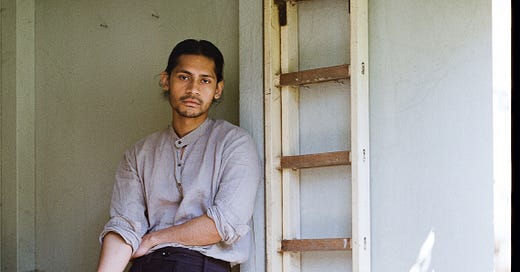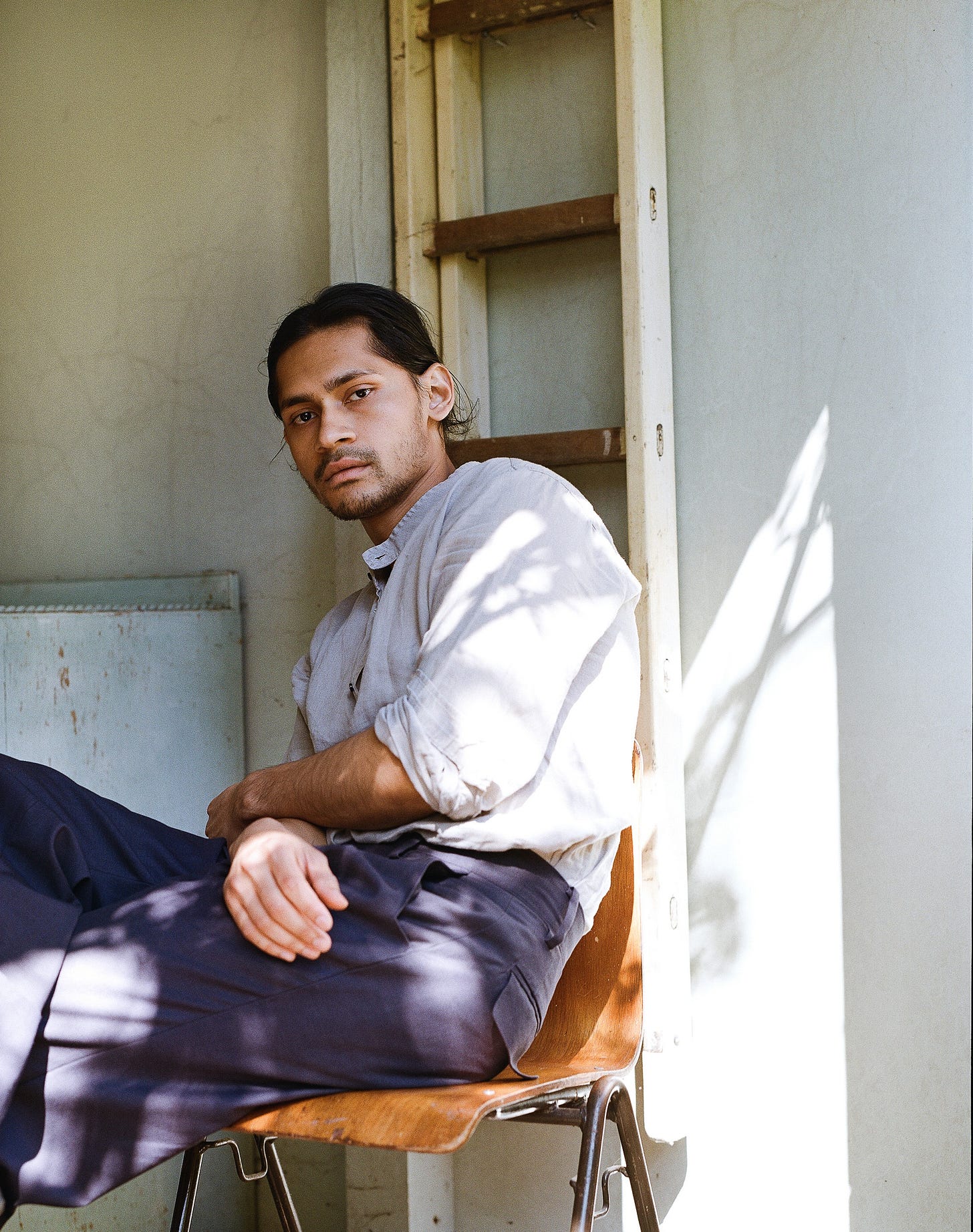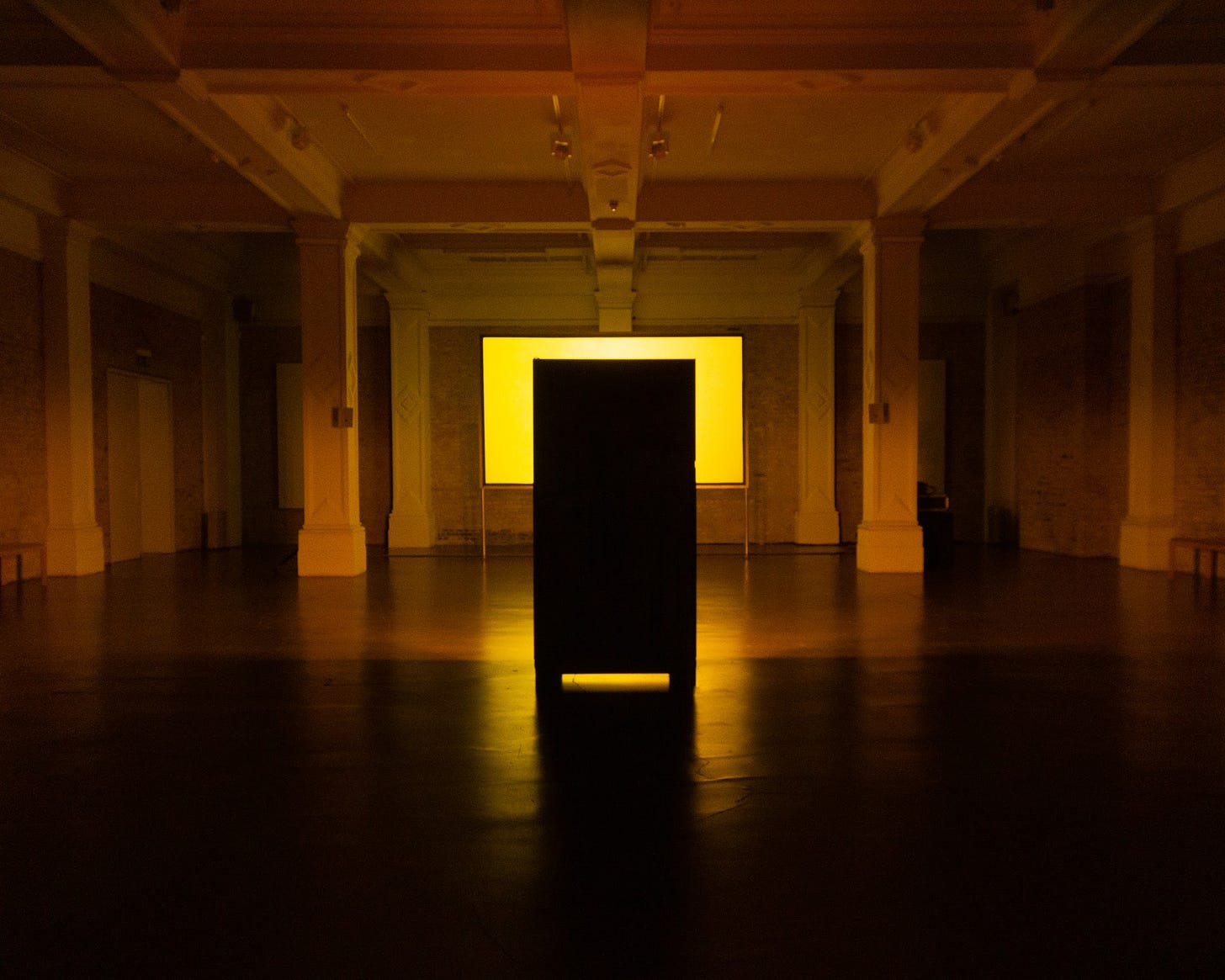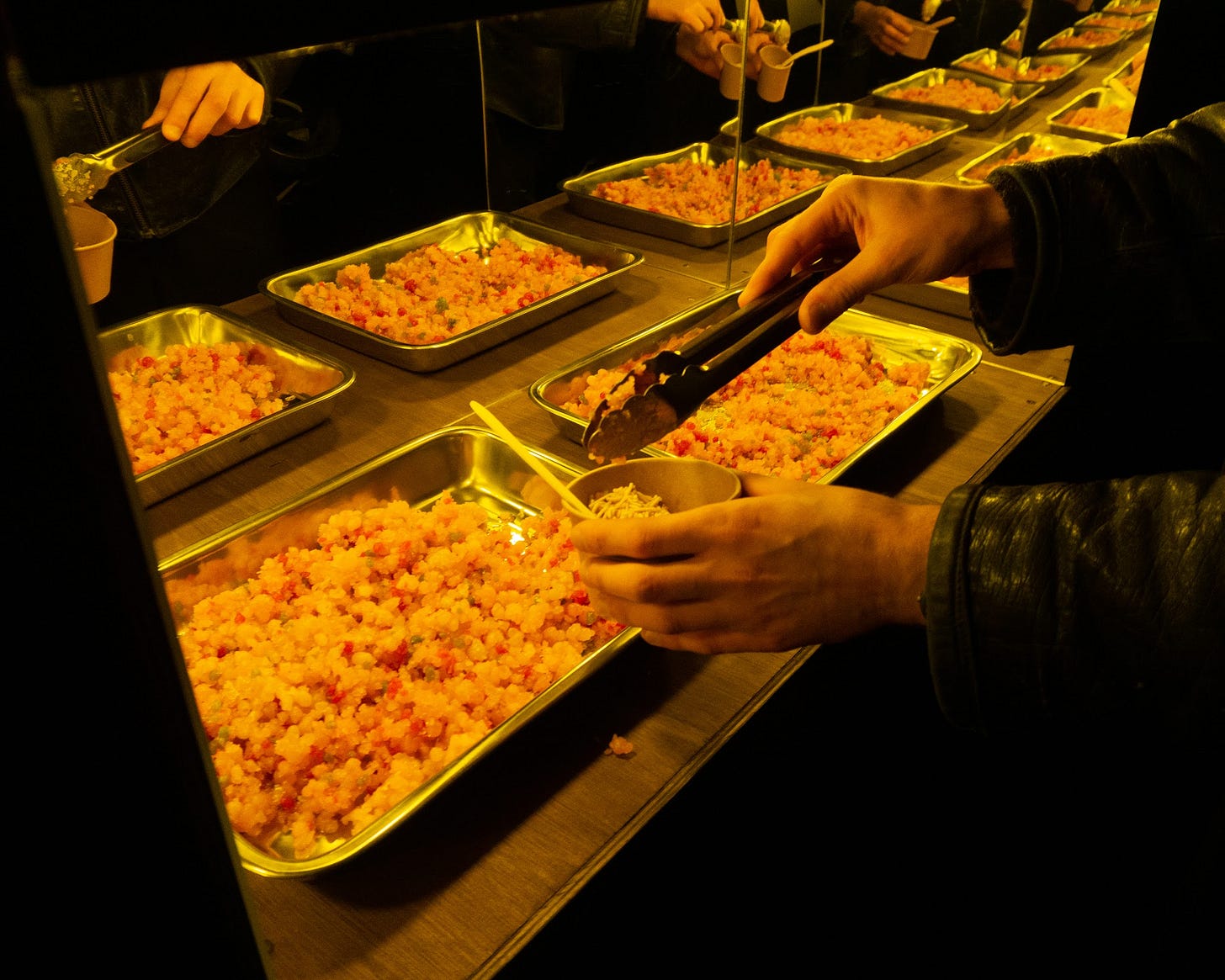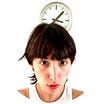Private Histories, Public Spaces: Laisul Hoque on the Vulnerability of Personal Art
A candid conversation tracing Hoque’s Bangladeshi roots, vulnerability, and self-exposure in London’s art scene.
A lot has changed for Laisul Hoque since our first meeting. Introduced by a mutual friend under the guise of helping him sort his visa, we had coffee together in Dalston about a year ago. As I talked him through the application process for the Global Talent Visa, he was unsure if he’d produced enough work to meet the long and convoluted criteria. What I thought would be a quick, transactional interaction turned into lunch, then evolved into a shared desire to create a space for creatives to connect over food. This ultimately led to us co-founding When They Meet with a few friends and, later, to becoming close friends.
Since then, Laisul has kept himself incredibly busy. Recorded on a camera purchased by the artist’s father in 2004 to document his journey through Europe and London when he couldn’t bring his family along, his 2023 short film The Purpose was to Document the Other Side, uses his mother’s visit to London as a gateway to explore complicated family dynamics and generational trauma. The film quickly garnered attention through multiple screenings in both London and Dhaka, which culminated in him being a finalist for the CIRCA PRIZE 2024, having his work screened on London’s iconic Piccadilly Lights.
By that point, Laisul had already begun working on a new project, An Ode to All the Flavours, an interactive installation piece where audiences are invited to taste the memory of his father’s favourite childhood snacks. This piece is part of his ongoing exploration of familial bonds, hegemonic masculinities, and the expression of emotion through gestures. I had the pleasure of witnessing this work last November during its one-day exhibition at Whitechapel Gallery. Laisul partners with Bengali sweet shops in London to bring the artist’s father’s favourite childhood snack into the gallery. At Nunnery Gallery, the food is freshly prepared and delivered daily by Oitij-jo Kitchen, an East London social enterprise empowering local Bengali women to achieve financial independence. Hoque’s installation secures Nunnery Gallery as a paid retainer client of Oitij-jo Kitchen for the duration of the exhibition, supporting their mission and amplifying their social impact. Not only is An Ode to All the Flavours visually stunning and deeply moving, but I also quickly understood why his father loved that snack so much – I find myself craving it every other week since then. Clearly, I wasn’t the only one impressed, as Laisul went on to win the East London Art Prize, chosen from over 870 submissions by artists and collectives living or working within the ‘E’ postcode.
Following the prize announcement, I attended his insightful conversation with Zarina Muhammad at the Nunnery Gallery. I was struck by his reflections on his relationship with his father and the implications of unpacking these intimate experiences in a public space. Anyone who has spent more than five minutes with me knows that self-exposure through art, the distinctions between the public and private spheres, and the right to share your own experiences have long preoccupied my life and writing. So, I invited Laisul for a chat on this topic—to interrogate the tricky, porous realm of life imitating art imitating life.
I’ll add the classic “This interview has been edited for length and clarity,” not because it’s strictly necessary—I assume most readers know a Q&A isn’t a word-for-word transcript of a 43-minute, 5,466-word conversation—but because this was truly a collage. A mutual friend used to say he’d go insane listening to Laisul and me converse; it’s tangents upon tangents, interfering references, and circling back to the topic half an hour later. It’s important to point this out as we dive into the interview: the awareness that it represents a conversation, but will never capture the exact memory of it.
Here, I present to you our accumulation of thoughts, references, and feelings on what it means to create personal work, to be an artist, and to experience the pleasures and pains of self-exposure. I hope you will consider it a love letter to the vulnerabilities that drive us to create and share the most intimate parts of our lives through art.
A lot of your work draws from your life, whether it's the archival footage in The Purpose was to Document the Other Side or the role of your father’s favourite snack in An Ode to All the Flavours. There's a level of self-exposure that comes with that. How do you negotiate boundaries around your work, how do you decide what to share and what to keep private?
That’s something I think about a lot… It's tricky to navigate that space, but if I'm not balancing on that tightrope, it doesn't feel like something that's pressing. If I produce a work and feel too comfortable putting it out, it feels too safe.
I am inspired by Annie Erneaux, and the way she’s able to put into words these moments we will all eventually experience in life. There’s a very intimidating passage in A Man’s Place of her looking at her father's naked body for the first time in preparation for his funeral. It is something everybody will probably have to do in some capacity, but I wouldn’t know what to do if that moment came, how to prepare myself for it. This is why I enjoy literature, it helps put you in somebody else’s shoes and prepare for life a little better.
I often think about her work as well. The Years is one of my favourite books. It's absolutely gorgeous, I really appreciate her exploration of the singular as a gateway to the plural.
Yes, it reminds me of this element that I try coping with, of taking a cultural group that is so coded into a specific lived experience and trying to make it universal. It is something I consider when I’m deciding what to put out and what not to put out, it’s a point which has been explored by many artists in different ways.
I come from a documentary and street photography practice, and I often think about how a big part of the documentary archives of our lived experiences was made by white photographers. I live with the understanding that throughout history, I have been the point of gaze by the outside world. How do I reclaim that narrative while remaining authentic to the complexities of the picture I am presenting?
It's so difficult to turn the lens your way, to portray the most authentic and intimate aspects of your lived experience by photographing yourself, your family, your parents. I have a particular soft spot for photographers who have been the point of gaze who are now deciding to take that camera and point it towards somebody else. It's the hardest thing to do because the tool itself is designed to create otherness.
When I was preparing for this conversation and considering what I wanted to ask you, I remembered this quote. “Whose story is yours to tell? What are the parameters of your ‘I’ and are you speaking within these bounds? If your truth is your truth, my truth is my truth, then whose true is truth?” I think a lot about the ethics of auto-theoretical work, about the fact that in speaking about your own life you will always involve the people around you. I’ve often struggled with how to portray people fairly and respectfully, especially when it comes to my family, as it’s challenging to consider how they’ll respond to my interpretation of events and the perspective I choose. I was particularly interested in your conversation with Zarina, where you mentioned your father’s reaction to your work. How do you navigate that balance in your practice?
What did you quote, what’s the book?
Oh, it’s Autotheory as Feminist Practice in Art, Writing, and Criticism by Lauren Fournier. It’s one of my favourite books, you can borrow my copy if you want.
For The Purpose was to Document the Other Side, I explained the concept to my mother and asked, “Can we make a film together in this very charged object that is the camera,” and she agreed to it. An Ode to All The Flavours, on the other hand, sits somewhere between revenge and homage. It’s confusing because it's very hard to deny or reject when somebody puts on, in a sense, a monument of you. At the same time, it’s complex because it's not presenting an icon that is a flat picture, it comes with layers of criticism. Part of the process is packaging it in a manner that is charged not only for myself but also for the people that I'm making it with.
All of these practices have always been about paying homage, about using the little agency I have to fix the relationships immediately surrounding me. It was never about the art world. If the institutions don't pick them up, the work still does its job. I still get to make a film about my mom on a camera that my dad bought and we get to watch it. If I get to set up a sweet shop and distribute my father's favourite childhood snack, it still makes my father happy. It allows us to have the conversations we want through those snacks.
Yeah, you're doing it cause it fulfils you. What are you most excited to explore right now?
I want to expand the story. My work always starts with me and my immediate surroundings, which are my parents, but I want to take it a bit further from there. I'm interested in hearing personal experiences that have been shaped by global politics, in trying to make sense of the wider circumstances we have lived through.
I'm talking a lot right now, but a big part of my practice also has been listening. In Can the Subaltern Speak?, Gayatri Spivak makes the big claim that the subaltern cannot speak, maybe because the languages that we operate in are colonial, and it doesn't translate. I see myself as a vessel which can listen.
I want to know about your creative process. There’s a Substack I’m obsessed with, Subtle Maneuvers, which explores different artists’ routines and rituals. How does your work come about?
I'm very interested in challenging the notion of the cinematic as a visual language. There are certain experiences and feelings that I find cinematic but don't know how to put into images.
I often look back at my past, and because I'm fairly young, many experiences are blurred memories I don’t have answers to. Moments come back when I'm listening to songs on my way to work, when I'm reading books, when I’m dreaming. These thoughts linger in my head, and when I feel they are bothering me too much I write them down in a diary and decide to decode them. From there, it just becomes a whole array of project management to figure it out.
Does the process of doing that make you feel closer or further away from the core memory? There’s a Siri Hustvedt quote that has lived in my mind rent-free for years, it goes, “Writing is always for someone. It takes place on the axis of discourse between me and you. Even diaries and journals are for an other, if only another self, the person who returns to the words years later and finds an earlier version of what he or she is now. […] Writing lifts us out of ourselves, and that leap onto paper, that objectification, spurs reflective self-consciousness, the examination of self as other. […] Writing is a movement from one place to another, a form of traveling, and once the journey is over, the resulting text may help organize a person’s view of her subjectivity as she regards it now from the outside, instead of from the inside. The words become that alien familiar. Sometimes this externalized self on paper can become a lifeline, a more organized mirror image that makes it possible to go on.”
I mean, most of my practice is just project management at this point. It’s calling vendors and being super organized, which is not something I ever expected to do as an artist.
There’s a lot of weight to all these memories that I have. When my mom visited me in London and I decided to record it on my camera, I was at a point where I convinced myself I wouldn’t make it as an artist. I felt like a failure, but then I thought, "Hey, since I'm in London, at least I can bring my mom here and help her experience this. I’ll make it my own and hold onto that memory." In that context, I began using these found images—my family's archival images—and decided to overlay them with my mother's narrative. This act of erasing one story and rewriting it with another isn’t explicitly visible in my work, but the act itself carries a lot of emotional weight for me. Nobody witnessed that action, it was just me doing cinematic shit in my own space because I enjoy the beauty of that gesture.
Once I decided to show the film, people received it in various ways. Then, when the July revolution happened in Bangladesh, I was cut off from my family for an entire month, like so many others. Suddenly, this decision to capture such an intimate lived experience on video became very charged, because there was a slight possibility that this might be all we would ever have. This could be the last time.
With An Ode to All the Flavours, when it's being shown, it also has a social impact. It’s an attempt to actively change and mobilize the community, to give them skills and distribute funds. That becomes a different reading of the work.
Was that element there from the start? When did that project come from?
An Ode to All the Flavours came from my desire to create a physical manifestation of a charged memory. To make that possible, it required funding applications and involved people asking, “How do we benefit from you doing this?” In today’s world, every job somehow serves society. Whether you're a doctor or a TfL driver, you're contributing to society. Artists, however, can get away with not serving anyone because being an artist is so open and elusive—it defies labels, structures, and forms. But if I want to produce a work that exists within society and make a living from it, it has to serve. I really enjoyed figuring out how it could serve everyone.
There is a certain climate in our current funding structure where money goes to people who make art in a useful manner, with a sense of resource redistribution. Some argue that this decreases the parameters of art, and that could be true, but it ties back to existing in a world where everybody goes on to serve society, and I dream of that kind of world where everybody serves society and not just themselves. Maybe there's a way to do both—I’m trying to explore that.
Since we were talking about food, I wanted to ask you about When They Meet. How does that fit into the bigger picture of your practice?
Behind the individual, there is always a collective struggle and shared resources. Because I’ve won an award or whatever, my name is at the forefront of a lot of things, with my face and name tied to it. It’s easy to understand as an image because it's a flat representation, and the world enjoys individualistic struggle and success. However, the work never happens on its own. Hannah Arendt debunked the idea of the lone philosopher sitting alone and creating work. It’s always a collective effort, and somehow, someone makes sense of the narrative formed from that collective. In a racist society, somebody is chosen to lead that narrative, and that person's name gets plastered everywhere.
No work is created in isolation. I don’t believe I can function that way, which is why community, collective resource sharing, and chosen families become essential. We all live in a society, and it only works when we have empathy for one another.
That’s why When They Meet is very important because we live in a time that promotes individualism and isolated experiences in a constructed digital world. It prevents us from expressing our emotions and being vulnerable. It sets strong boundaries between what is private and what is public, and it’s a form of castration of human beings. The digital world is a beautiful thing—it’s the reason why we can meet remotely today—and, in theory, it provides us with a lot of free and accessible information, but that is under threat as we are seeing a new form of the digital world which is the cause of our isolation.
I see the importance of leading physically. It doesn't matter if it's in a big city or a village, I think meeting and physically sharing resources is a very big part of my artistic imagination. That's where When They Meet comes in, that's an initiative that I want to be a part of that goes very much and in hand in terms of the practice that I have.
In my practice, I want to expose not only the complexities of my lived experience but also universal aspects of the human experience, and that kind of conversation only forms when we come together and engage in a society or try to create one to begin with.
Thank you so much, I really appreciate that. I’m wondering, is there anything else you want to talk about?
Yes, when you shared with me that you wanted to discuss the negotiation of the boundaries of life and art, I immediately thought about certain points that I wanted to share with you.
First, I thought of Aristotle’s concept of mimesis, life imitating art. It’s a strand of Greek philosophy but also, in biology, mimesis is “a form of crypsis where living creatures mimic the form, colour and posture of their surrounding to avoid being noticed by predators.” I find it fascinating as it's a form of expression, of creation, but it's also a form of covertness. It protects you.
The other strand of thought is how art mimics life because we all talk about and write about things that happen in life. It helps us align our lens into these live experiences and empathise with others better.
At a certain point in history, that conversation changed, and it became “life imitates art.” We consumed so much art and all of a sudden we started seeing things in a cinematic way. Vilém Flusser, who wrote Towards a Philosophy of Photography, did this beautiful talk where he spoke about how the photograph was supposed to capture the event that was happening but, at some point in history, resistance movements started hijacking planes to make a point so they could be included in the image, so they could get on international television and get a say.
In the beginning, there was the event and the image was photographing the event, but that position switched and the image became more important than the event itself, to the point where the event got completely replaced by the image.
For example, in wedding photography, the whole point is how it will be looked at in retrospect. It goes hand in hand with life imitating art versus art imitating life. We live in an era where fiction writes itself. Looking back into the fiction and reading it in a different context is something that I find fascinating.

